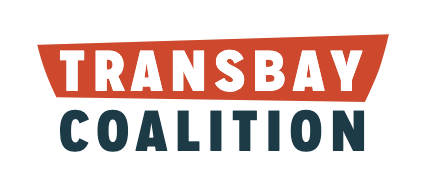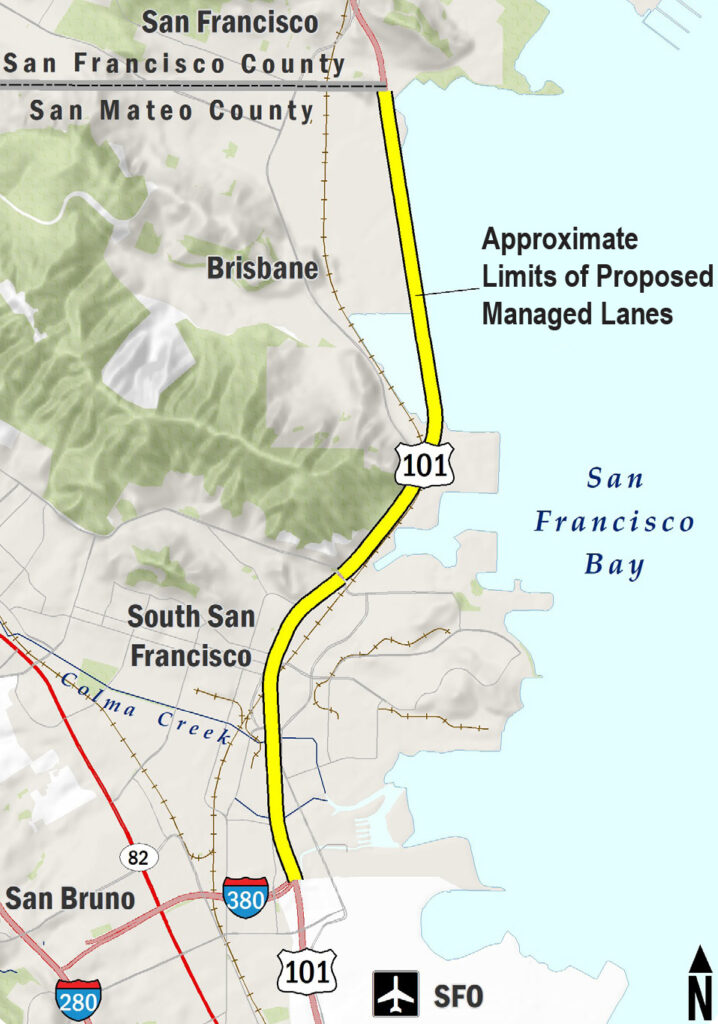Contributed by Sustainable South City
The next phase of the 101 managed lanes project, a segment through South San Francisco, is in the works. A coalition in South San Francisco, coordinated by members of Sustainable South City wants the project to avoid adding a new lane to the highway.
Rather than adding these lanes by expanding the freeway as has been done in previous segments, the coalition is urging C/CAG, SMCTA, and Caltrans to convert an existing mixed-use lane into a managed lane. This would avoid widening the freeway and put downward pressure on vehicle miles traveled by incentivizing carpooling and transit use, thus tackling congestion without the harm caused by induced demand.
In a letter sent to the project’s sponsors, the coalition states: “While we agree that congestion is a problem and that we need to better manage automobile travel, adding lanes will only offer short-term benefits to traffic flow while causing long-term harm to the climate, environment, and surrounding vulnerable communities.”
About the South City managed lanes
The project area will start one mile south of the U.S. 101/I-380 interchange in South San Francisco, and extend about one mile north of the San Mateo/San Francisco County Line, adding approximately 9.4 miles of managed lanes in each direction.
The project is a joint effort between San Mateo County Transportation Authority (SMCTA), San Mateo City/County Association of Governments (C/CAG), and Caltrans, is one of a series of efforts to add high-occupancy expressways along the length of U.S. 101.
The project is currently in the environmental scoping phase, with Environmental Review and Project Approval expected in January 2023. Design is expected to be completed by December 2025, followed by construction from January 2026 through December 2027.
Adding lanes increases driving and pollution, undermining transit investments
Though adding capacity to a roadway seems like an intuitive solution to congestion, it would likely have the opposite effect. If the planned managed lanes are created through freeway expansion, it will increase annual regional vehicle miles traveled by at least 145.3 million miles a year, according to an Induced Travel Calculator developed by the UC Davis National Center for Sustainable Transportation (NCST). Adding new lanes, even managed lanes, causes more people to drive more often, increasing traffic both along the project site and in the region as a whole. This phenomenon is known as induced demand.
That’s nearly 400,000 additional vehicle miles traveled a day. Meanwhile, Caltrain electrification is expected to reduce vehicle miles travelled by 235,000 miles per day. So, expanding the highway undermines the progress the region is seeking by spending over $2 billion to modernize its rail line.
Though vehicles are becoming much more energy efficient, traffic pollution remains a major problem. Even fully electric vehicles have issues like upstream emissions, brake dust, and microplastics released by tire wear.
Compounding the problem is the fact that the project area cuts through the heart of South San Francisco, which holds some of the Bay Area’s oldest Equity Priority Communities. Any expansion would disproportionately affect these vulnerable areas, one of which is already in the 96th percentile of most polluted census tracts in California.
Can Caltrans change its highway-expanding ways?
Early talks by coalition members with Caltrans’ sustainability team have confirmed that the coalition’s solution aligns with current state and agency policies. Recent legislation has gone into effect requiring Caltrans to focus on lowering vehicle miles traveled. Caltrans has since released several documents indicating the ways they would follow this mandate, including a VMT-Focussed Transportation Impact Study Guide and a Transportation Analysis Framework that recommends use of the same NCST induced travel calculator used by the coalition.
Still, the group knows they’re pushing back against a great deal of inertia. Nearly all high-occupancy lanes since the mid-1970s have been added through new construction, rather than by converting an existing mixed-use lane. Additionally, Caltrans’ recent Environmental Impact studies continue to downplay the idea of induced demand, a regular occurrence, according to NCST. The most recent 101 managed lane project further south in San Mateo county recently broke ground despite having environmental reviews (EIR/EAs) that dismissed the possibility of induced demand.
How to get involved
Organizers are looking to connect and collaborate with other activist groups, concerned citizens, and planning and transportation experts.. If you or anyone you know are interested in getting involved with this effort, please contact sustainablesouthcity@gmail.com.

